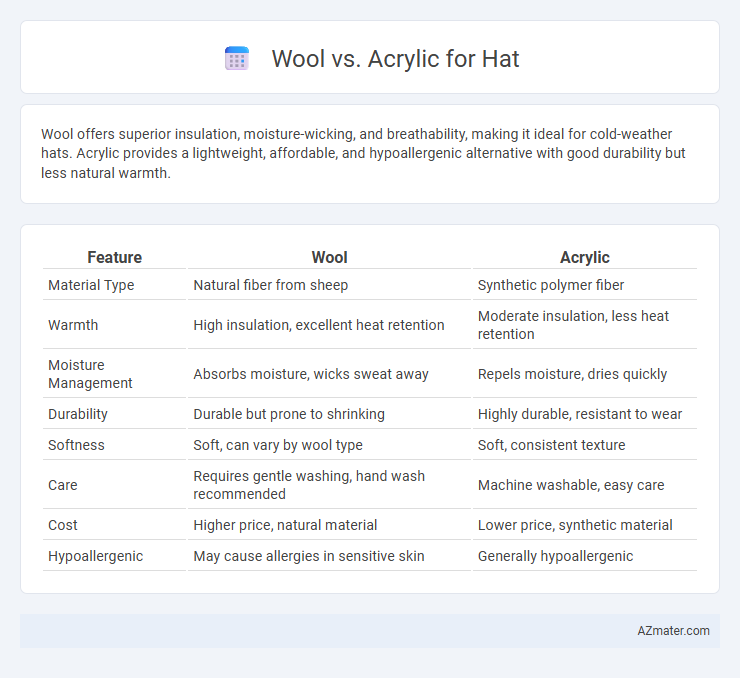Wool offers superior insulation, moisture-wicking, and breathability, making it ideal for cold-weather hats. Acrylic provides a lightweight, affordable, and hypoallergenic alternative with good durability but less natural warmth.
Table of Comparison
| Feature | Wool | Acrylic |
|---|---|---|
| Material Type | Natural fiber from sheep | Synthetic polymer fiber |
| Warmth | High insulation, excellent heat retention | Moderate insulation, less heat retention |
| Moisture Management | Absorbs moisture, wicks sweat away | Repels moisture, dries quickly |
| Durability | Durable but prone to shrinking | Highly durable, resistant to wear |
| Softness | Soft, can vary by wool type | Soft, consistent texture |
| Care | Requires gentle washing, hand wash recommended | Machine washable, easy care |
| Cost | Higher price, natural material | Lower price, synthetic material |
| Hypoallergenic | May cause allergies in sensitive skin | Generally hypoallergenic |
Introduction: Choosing the Right Material for Hats
Wool and acrylic are popular materials for hats, each offering distinct benefits in warmth, durability, and comfort. Wool provides superior insulation and moisture-wicking properties, making it ideal for cold weather, while acrylic is lightweight, hypoallergenic, and more resistant to wear and fading. Selecting the right material depends on factors such as climate, skin sensitivity, and maintenance preferences to ensure optimal performance and style.
Wool vs Acrylic: Basic Material Overview
Wool, a natural fiber sourced from sheep, offers superior breathability, moisture-wicking properties, and insulation, making it ideal for hat materials requiring warmth and comfort. Acrylic, a synthetic fiber derived from polymer chemicals, provides durability, lightweight warmth, and easy care but lacks the natural temperature regulation found in wool. Understanding the distinct molecular structures and thermal properties of wool versus acrylic helps in choosing hats optimized for either natural insulation or synthetic resilience.
Warmth and Insulation: Which Is Better?
Wool provides superior warmth and insulation for hats due to its natural crimped fibers that trap heat and wick moisture, maintaining body temperature even when damp. Acrylic, while lighter and moisture-resistant, offers less effective insulation and can lose heat retention compared to wool. Choosing wool ensures enhanced thermal regulation and comfort in cold weather conditions.
Comfort and Texture: Feel on the Skin
Wool hats provide natural warmth and excellent breathability, offering a soft, slightly coarse texture that adapts to body temperature while wicking moisture away, making them comfortable for extended wear. Acrylic hats mimic the softness of wool but tend to feel smoother and less irritating against sensitive skin, although they may retain heat and moisture more than wool. Choosing between wool and acrylic depends on personal sensitivity to fibers and the desired balance between breathability and smoothness in hat comfort.
Durability and Longevity of Wool and Acrylic Hats
Wool hats offer superior durability due to their natural resilience and ability to retain shape over time, making them highly resistant to wear and tear. Acrylic hats, while initially soft and lightweight, tend to pill and lose elasticity more quickly under frequent use, reducing their longevity. The moisture-wicking and breathable properties of wool also contribute to its long-lasting quality compared to acrylic fibers that can degrade with exposure to heat and sunlight.
Care and Maintenance: Washing and Drying
Wool hats require gentle hand washing with cold water and mild detergent to prevent shrinking and felting, followed by air drying flat away from direct heat sources. Acrylic hats are more durable in care, allowing machine washing on a gentle cycle with cool water, and can be tumble dried on low heat without significant damage. Proper care extends the lifespan of both materials, with wool demanding more delicate handling compared to the low-maintenance nature of acrylic.
Hypoallergenic Properties: Sensitivity Considerations
Wool hats offer natural breathability and moisture-wicking properties but may trigger allergic reactions or skin irritation in individuals sensitive to lanolin or animal fibers. Acrylic hats, made from synthetic fibers, are typically hypoallergenic and less likely to cause itching or rashes, making them a preferred choice for those with sensitive skin or wool allergies. Choosing between wool and acrylic involves evaluating personal sensitivity, with acrylic providing a safer option for allergy sufferers while wool delivers superior insulation.
Environmental Impact: Wool vs Acrylic Sustainability
Wool is a renewable, biodegradable fiber derived from sheep, producing lower carbon emissions and supporting sustainable farming practices, making it an eco-friendly choice for hats. Acrylic, a synthetic fiber made from petroleum-based chemicals, has a larger carbon footprint, takes centuries to decompose, and contributes to microplastic pollution. Choosing wool over acrylic reduces reliance on fossil fuels and environmental harm while promoting sustainable textile production.
Style and Color Options: Versatility in Design
Wool hats offer timeless style with natural texture and rich, earthy tones that complement classic and rustic fashion, while acrylic hats provide an extensive range of vibrant colors and patterns due to synthetic dye compatibility. Acrylic fibers enable versatility in design, allowing for bold, modern styles and easy maintenance, making them ideal for trend-conscious wearers. Wool's natural insulation combined with its muted palette suits subdued, elegant looks, whereas acrylic's color versatility supports eclectic and customizable hat designs.
Cost Comparison: Value for Money
Wool hats typically cost more upfront but offer superior insulation, durability, and breathability, providing better long-term value for money. Acrylic hats are generally cheaper and lightweight, making them budget-friendly but less effective in warmth and wear resistance. Consumers seeking a balance between cost and performance often consider wool as a worthwhile investment despite higher initial costs.

Infographic: Wool vs Acrylic for Hat
 azmater.com
azmater.com